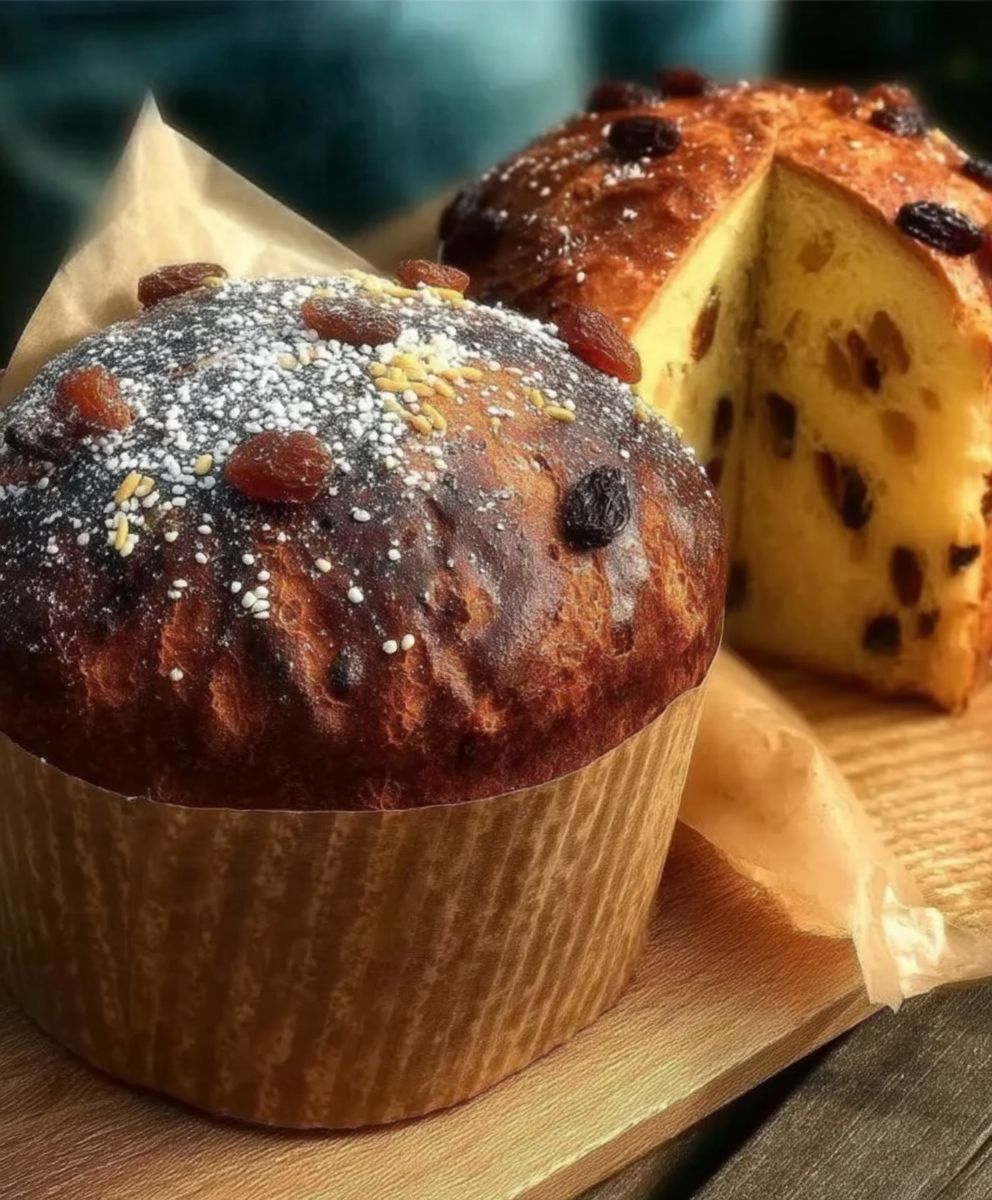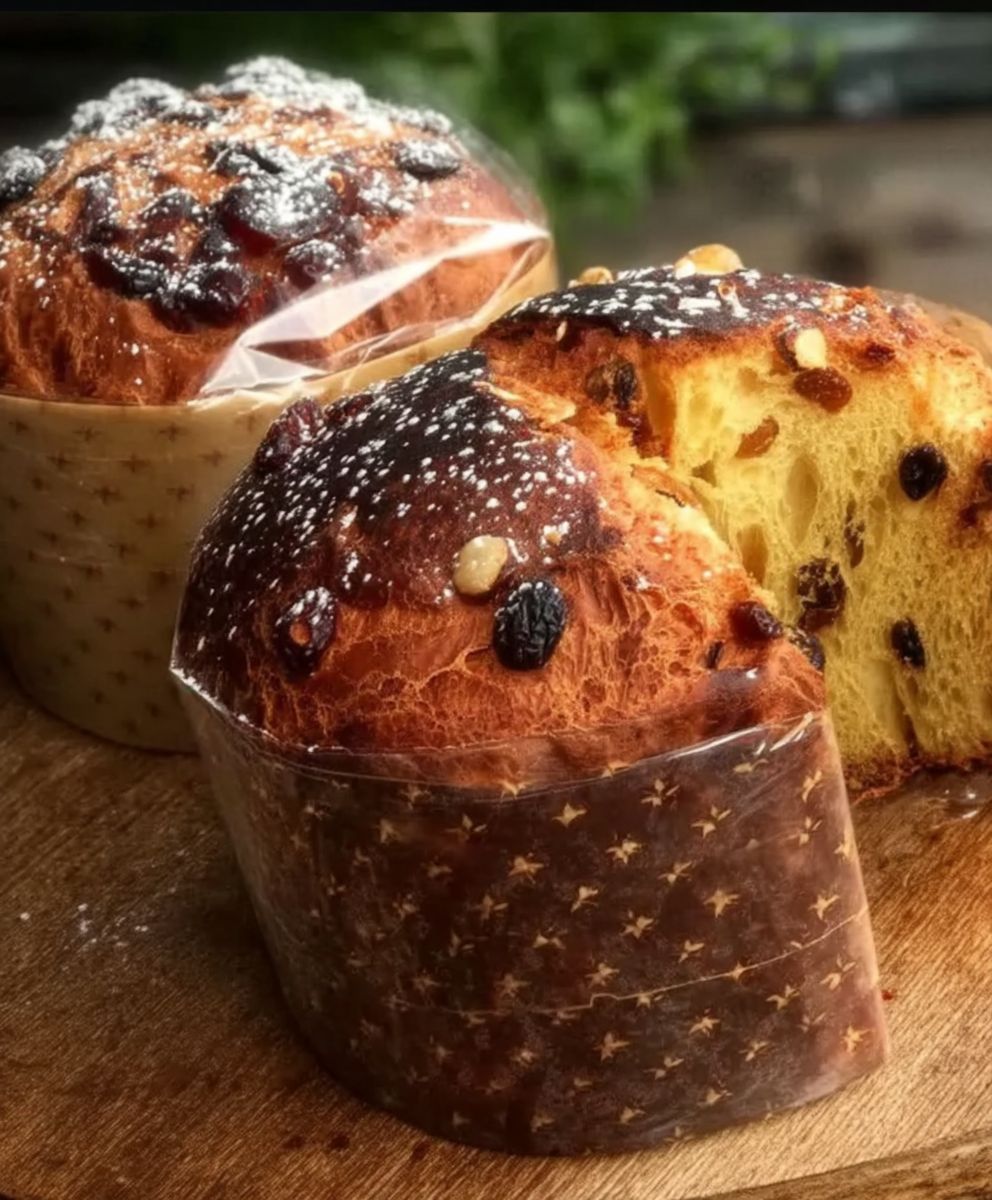Homemade Panettone, that iconic Italian sweet bread, might seem intimidating to bake at home, but trust me, the reward is absolutely worth the effort! Imagine pulling a golden, fragrant dome from your oven, its airy crumb studded with candied citrus and plump raisins. The aroma alone is enough to transport you to a bustling Milanese pasticceria.
Panettone boasts a rich history, deeply intertwined with the traditions of Milan. Legend has it that a kitchen boy named Toni accidentally created the first panettone while trying to save a burnt dessert for a Christmas Eve feast. Whether fact or folklore, this sweet bread has become a symbol of Italian Christmas, shared amongst family and friends during the festive season.
What is it about homemade panettone that captivates so many? It’s the perfect combination of textures a light, almost feathery crumb that melts in your mouth, contrasted by the chewy sweetness of candied fruit. The subtle tang from the long fermentation process adds a depth of flavor that you simply can’t find in store-bought versions. Plus, there’s something incredibly satisfying about creating this masterpiece from scratch. This guide will break down the process into manageable steps, ensuring your panettone journey is a delicious success. Let’s get baking!
Ingredients:
- For the First Dough (Lievito Madre Activation):
- 100g strong bread flour (12-14% protein)
- 50g water, lukewarm
- 20g active sourdough starter (Lievito Madre), refreshed
- For the Second Dough (First Refreshment):
- 150g strong bread flour (12-14% protein)
- 75g water, lukewarm
- All of the first dough (Lievito Madre activation)
- For the Third Dough (Second Refreshment):
- 200g strong bread flour (12-14% protein)
- 100g water, lukewarm
- All of the second dough (First Refreshment)
- For the Main Dough:
- 500g strong bread flour (12-14% protein)
- 150g granulated sugar
- 150g unsalted butter, softened
- 150g egg yolks (about 8-9 large egg yolks)
- 100g water, lukewarm
- 10g honey
- 8g salt
- Zest of 1 orange
- Zest of 1 lemon
- 1 vanilla bean, seeds scraped (or 1 tsp vanilla extract)
- For the Candied Fruit and Raisins:
- 200g candied orange peel, diced
- 100g candied lemon peel, diced
- 150g raisins, soaked in warm water or rum for at least 2 hours, then drained well
- 20g unsalted butter, melted (for coating the fruit)
- 20g flour (for coating the fruit)
- Equipment:
- Panettone paper molds (1 kg size)
- Kitchen thermometer
- Stand mixer with dough hook attachment
- Two long knitting needles or skewers
Activating the Lievito Madre (Sourdough Starter)
This is a crucial step, so pay close attention! We need to ensure our sourdough starter is strong and active to leaven the Panettone properly. This process takes place over three refreshments.
First Dough (Lievito Madre Activation):
- In a clean bowl, combine 100g of strong bread flour and 50g of lukewarm water. Mix until a shaggy dough forms.
- Add 20g of your active, refreshed sourdough starter. Knead the mixture until a smooth dough forms. This can be done by hand or in a stand mixer with a dough hook.
- Shape the dough into a ball and score a cross on top. Place it in a tall, narrow container (like a measuring cup) marked with the starting level.
- Cover loosely with plastic wrap and let it rise in a warm place (around 75-80°F or 24-27°C) until it triples in size. This should take about 3-4 hours, but it depends on the strength of your starter.
Second Dough (First Refreshment):
- Once the first dough has tripled, it’s time for the first refreshment. In a clean bowl, combine 150g of strong bread flour and 75g of lukewarm water.
- Add all of the first dough (the tripled Lievito Madre). Knead the mixture until a smooth dough forms.
- Shape the dough into a ball and score a cross on top. Place it in a tall, narrow container marked with the starting level.
- Cover loosely with plastic wrap and let it rise in a warm place (around 75-80°F or 24-27°C) until it triples in size again. This should take about 3-4 hours.
Third Dough (Second Refreshment):
- After the second dough has tripled, it’s time for the final refreshment. In a clean bowl, combine 200g of strong bread flour and 100g of lukewarm water.
- Add all of the second dough (the tripled Lievito Madre). Knead the mixture until a smooth dough forms.
- Shape the dough into a ball and score a cross on top. Place it in a tall, narrow container marked with the starting level.
- Cover loosely with plastic wrap and let it rise in a warm place (around 75-80°F or 24-27°C) until it triples in size one last time. This should take about 3-4 hours. Your Lievito Madre is now ready to use!
Preparing the Main Dough
Now that our Lievito Madre is active and ready, we can move on to the main dough. This is where the magic really happens!
- First Mixing Stage: In the bowl of a stand mixer fitted with the dough hook, combine the Lievito Madre (all of the third dough), 500g of strong bread flour, 150g of sugar, and 100g of lukewarm water. Mix on low speed until a shaggy dough forms.
- Increase the speed to medium and knead for about 10-15 minutes, or until the dough becomes smooth, elastic, and pulls away from the sides of the bowl. It should be quite strong and developed.
- Adding the Egg Yolks: With the mixer still running on medium speed, add the egg yolks one at a time, allowing each yolk to be fully incorporated before adding the next. This process should take about 5-7 minutes. The dough will become very soft and sticky. Don’t worry, it will come together!
- Adding the Butter: Gradually add the softened butter, a tablespoon at a time, allowing each piece to be fully incorporated before adding the next. This is a slow process, and it’s crucial for the final texture of the Panettone. It should take about 15-20 minutes. The dough will seem like it’s falling apart, but keep going! It will eventually emulsify and become smooth and glossy.
- Adding the Honey, Salt, Zest, and Vanilla: Add the honey, salt, orange zest, lemon zest, and vanilla bean seeds (or vanilla extract). Mix on low speed until everything is evenly distributed.
- First Proofing: Transfer the dough to a lightly oiled bowl. Cover tightly with plastic wrap and let it rise in a warm place (around 75-80°F or 24-27°C) for about 12-14 hours, or until it has tripled in size. This is a long, slow proof, so be patient!
Incorporating the Candied Fruit and Raisins
This step adds the signature flavors and textures to our Panettone. Proper preparation of the fruit is key to preventing it from sinking to the bottom of the loaf.
- Preparing the Fruit: While the dough is proofing, prepare the candied orange peel, candied lemon peel, and raisins. If the raisins haven’t been soaked, do so now. Drain them thoroughly after soaking.
- Coating the Fruit: In a bowl, toss the diced candied orange peel, candied lemon peel, and drained raisins with the melted butter and flour. This coating will help prevent the fruit from sinking during baking.
- Incorporating the Fruit: After the first proof, gently deflate the dough. Turn it out onto a lightly floured surface.
- Spread the fruit evenly over the dough. Gently knead the fruit into the dough until it is evenly distributed. Be careful not to over-knead, as this can damage the gluten structure.
Shaping and Second Proofing
We’re almost there! Shaping the dough and allowing it to proof again will give our Panettone its final rise and beautiful dome shape.
- Dividing the Dough: Gently shape the dough into a round. If you are making multiple smaller Panettones, divide the dough accordingly. For a 1 kg Panettone, use all of the dough.
- Shaping the Dough: Gently shape the dough into a tight ball.
- Placing in the Mold: Carefully place the dough ball into the prepared Panettone paper mold.
- Second Proofing: Cover the mold loosely with plastic wrap and let it

Conclusion:
And there you have it! I truly believe this Homemade Panettone recipe is a must-try, especially if you’re looking to elevate your holiday baking or simply impress your loved ones with a truly special treat. The aroma alone, filling your kitchen with the scent of citrus, vanilla, and warm dough, is worth the effort. But beyond the delightful fragrance, the taste and texture of this homemade Panettone are simply unparalleled. Forget the store-bought versions this is the real deal.
What makes this recipe so special? It’s the combination of high-quality ingredients, the patient fermentation process that develops incredible flavor, and the satisfaction of knowing you created something truly extraordinary from scratch. It’s a labor of love, yes, but the reward is a light, airy, and incredibly flavorful Panettone that will have everyone begging for more.
But don’t just take my word for it! I urge you to give this recipe a try. I know the process might seem a little daunting at first, but I’ve broken it down into manageable steps, and I’m confident that even novice bakers can achieve amazing results. Remember to read through the entire recipe carefully before you begin, and don’t be afraid to ask questions if you get stuck. I’m always happy to help!
Now, let’s talk serving suggestions and variations. While this Homemade Panettone is absolutely delicious on its own, there are so many ways to enjoy it. For a simple yet elegant presentation, slice it and serve it with a dollop of mascarpone cheese and a drizzle of honey. Or, toast a slice and spread it with your favorite jam or marmalade for a delightful breakfast treat.
If you’re feeling adventurous, you can even use your Panettone to make French toast or bread pudding. The possibilities are endless! And for a truly decadent experience, try dipping slices of Panettone in melted chocolate. Trust me, you won’t regret it.
Looking for variations? Feel free to experiment with different dried fruits and nuts. Instead of the traditional candied orange peel and raisins, you could try using dried cranberries, apricots, or even chopped dates. As for nuts, almonds, walnuts, or pecans would all be delicious additions. You could also add a touch of spice, such as cinnamon, nutmeg, or cardamom, to the dough for an extra layer of flavor.
Another fun variation is to add chocolate chips to the dough. Milk chocolate, dark chocolate, or even white chocolate chips would all work well. Just be sure to use high-quality chocolate for the best results.
I’m so excited for you to try this recipe and experience the joy of baking your own Homemade Panettone. Once you’ve made it, I’d love to hear about your experience! Share your photos and stories on social media using [Your Social Media Hashtag], and let me know what variations you tried. I can’t wait to see your creations! Happy baking! This recipe is a guaranteed crowd-pleaser, and I know you’ll be proud to share it with your friends and family. Don’t hesitate, start your Panettone journey today!
Homemade Panettone Guide: Bake the Perfect Italian Christmas Bread
Classic Italian Panettone made with Lievito Madre (sourdough) for a rich, airy holiday bread. Features a three-stage sourdough activation, long first proof, and is filled with candied citrus and raisins.
Ingredients
- 100g strong bread flour (12-14% protein)
- 50g water, lukewarm
- 20g active sourdough starter (Lievito Madre), refreshed
- 150g strong bread flour (12-14% protein)
- 75g water, lukewarm
- All of the first dough (Lievito Madre activation)
- 200g strong bread flour (12-14% protein)
- 100g water, lukewarm
- All of the second dough (First Refreshment)
- 500g strong bread flour (12-14% protein)
- 150g granulated sugar
- 150g unsalted butter, softened
- 150g egg yolks (about 8-9 large egg yolks)
- 100g water, lukewarm
- 10g honey
- 8g salt
- Zest of 1 orange
- Zest of 1 lemon
- 1 vanilla bean, seeds scraped (or 1 tsp vanilla extract)
- 200g candied orange peel, diced
- 100g candied lemon peel, diced
- 150g raisins, soaked in warm water or rum for at least 2 hours, then drained well
- 20g unsalted butter, melted (for coating the fruit)
- 20g flour (for coating the fruit)
Instructions
- First Dough (Lievito Madre Activation): In a clean bowl, combine 100g of strong bread flour and 50g of lukewarm water. Mix until a shaggy dough forms. Add 20g of your active, refreshed sourdough starter. Knead the mixture until a smooth dough forms. Shape the dough into a ball and score a cross on top. Place it in a tall, narrow container marked with the starting level. Cover loosely with plastic wrap and let it rise in a warm place (around 75-80°F or 24-27°C) until it triples in size (3-4 hours).
- Second Dough (First Refreshment): Once the first dough has tripled, combine 150g of strong bread flour and 75g of lukewarm water in a clean bowl. Add all of the first dough (the tripled Lievito Madre). Knead until smooth. Shape into a ball, score a cross, and place in a tall container marked with the starting level. Cover and let rise in a warm place until it triples in size again (3-4 hours).
- Third Dough (Second Refreshment): After the second dough has tripled, combine 200g of strong bread flour and 100g of lukewarm water in a clean bowl. Add all of the second dough (the tripled Lievito Madre). Knead until smooth. Shape into a ball, score a cross, and place in a tall container marked with the starting level. Cover and let rise in a warm place until it triples in size (3-4 hours). Your Lievito Madre is now ready.
- First Mixing Stage: In the bowl of a stand mixer fitted with the dough hook, combine the Lievito Madre (all of the third dough), 500g of strong bread flour, 150g of sugar, and 100g of lukewarm water. Mix on low speed until a shaggy dough forms.
- Increase the speed to medium and knead for about 10-15 minutes, or until the dough becomes smooth, elastic, and pulls away from the sides of the bowl.
- Adding the Egg Yolks: With the mixer still running on medium speed, add the egg yolks one at a time, allowing each yolk to be fully incorporated before adding the next (5-7 minutes).
- Adding the Butter: Gradually add the softened butter, a tablespoon at a time, allowing each piece to be fully incorporated before adding the next (15-20 minutes).
- Adding the Honey, Salt, Zest, and Vanilla: Add the honey, salt, orange zest, lemon zest, and vanilla bean seeds (or vanilla extract). Mix on low speed until everything is evenly distributed.
- First Proofing: Transfer the dough to a lightly oiled bowl. Cover tightly with plastic wrap and let it rise in a warm place (around 75-80°F or 24-27°C) for about 12-14 hours, or until it has tripled in size.
- Preparing the Fruit: While the dough is proofing, prepare the candied orange peel, candied lemon peel, and raisins. If the raisins haven’t been soaked, do so now. Drain them thoroughly after soaking.
- Coating the Fruit: In a bowl, toss the diced candied orange peel, candied lemon peel, and drained raisins with the melted butter and flour.
- Incorporating the Fruit: After the first proof, gently deflate the dough. Turn it out onto a lightly floured surface. Spread the fruit evenly over the dough. Gently knead the fruit into the dough until it is evenly distributed.
- Gently shape the dough into a round. If you are making multiple smaller Panettones, divide the dough accordingly. For a 1 kg Panettone, use all of the dough.
- Gently shape the dough into a tight ball.
- Carefully place the dough ball into the prepared Panettone paper mold.
- Cover the mold loosely with plastic wrap and let it rise in a warm place (around 75-80°F or 24-27°C) for about 6-8 hours, or until the dough has risen to about 1-2 inches from the top of the mold.
- Preheat oven to 340°F (170°C).
- Using a sharp knife or razor blade, score a cross on the top of the dough. Place a small pat of butter (about 1 tablespoon) in the center of the cross.
- Bake for about 50-60 minutes, or until the internal temperature reaches 195-205°F (90-96°C). If the top is browning too quickly, tent it loosely with foil.
- Hanging Upside Down: Immediately after baking, insert two long knitting needles or skewers horizontally through the base of the Panettone, about 1-2 inches from the bottom. Turn the Panettone upside down and hang it between two tall pots or chairs. This prevents the Panettone from collapsing as it cools.
- Let the Panettone cool completely upside down (at least 6-8 hours, or preferably overnight) before slicing and serving.
Notes
- Lievito Madre is Key: The success of this recipe depends on a strong and active Lievito Madre. Make sure your starter is well-fed and doubles or triples consistently before using it.
- Temperature Control: Maintaining a consistent warm temperature during proofing is crucial. Use a proofing box, a warm oven with the light on, or a warm spot in your kitchen.
- Patience is a Virtue: This recipe takes time and patience. Don’t rush the proofing stages.
- Butter Incorporation: Adding the butter slowly is essential for creating the characteristic light and airy texture of Panettone.
- Hanging Upside Down: Don’t skip the hanging step! It’s vital for preventing the Panettone from collapsing.
- Fruit Soaking: Soaking the raisins in warm water or rum plumps them up and prevents them from drying out during baking.
- Storage: Store Panettone in an airtight container at room temperature for up to a week.





Leave a Comment